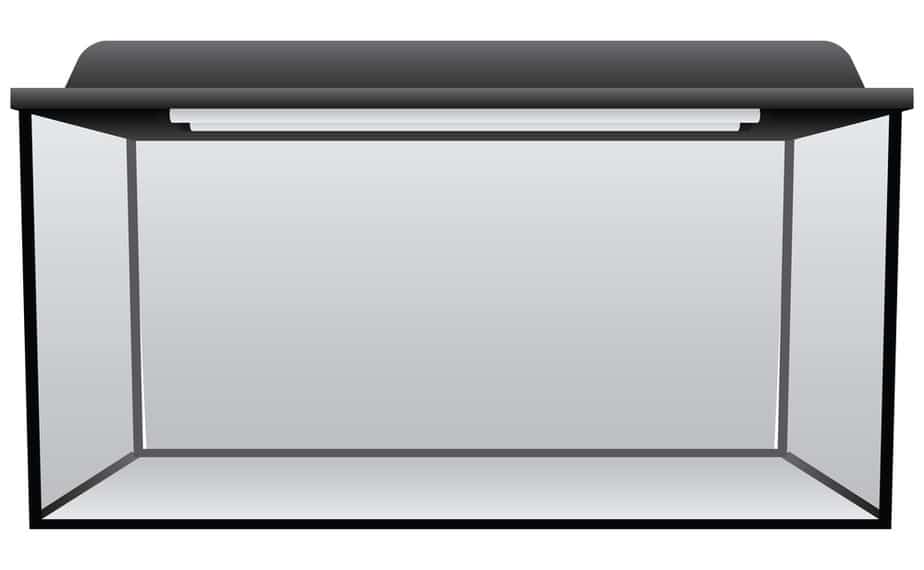Don’t put more than two leopard geckos in a 40-gallon tank. 40 Gallons will allow both geckos enough space to move around and thrive. Don’t put more than one male in the tank to prevent any possible territorial disputes.

- Provide at least two hiding spots (one for each).
- If you put two leopard geckos in the same tank, we recommend having a spare tank on hand in case they need separating.
See our best tanks for leopard geckos
Some people will tell you that you can put up to four leopard geckos in a 40 gallon tank. If you do this, make sure they are females, as males will fight with each other.
Personally, I recommend sticking with two, as managing the care of four leopard geckos in one tank is a lot of work.
Space Requirements Per Gecko
Each leopard gecko needs at least 10 gallons of space at a minimum. We highly recommend going even higher to 20 for the happiness and comfort of your Leo.
Territorial Behavior
While it is possible to keep multiple geckos together, their gender, species, size, and age play a significant role in compatibility.
For example, you can house a male and a female leopard gecko or two female leopard geckos together after they reach maturity. However, housing two male leopard geckos together can lead to aggressive behavior and should be avoided.
Ideal 40-Gallon Tank Setup
Tank Decor
You should provide at least one hiding area for each gecko in the tank. Some examples of hiding spots include:
- Ceramic logs
- Hollowed-out rocks
- Half-rounded cork bark
- Artificial caves
In addition to hiding spots, add some decorations and climbing options, such as branches and fake plants, to make the geckos feel more comfortable.
Heating and Lighting
Leopard geckos are cold-blooded creatures and require proper heating and lighting. Here’s what you need to consider:
Heating:
- Under-tank heaters: Place these heaters beneath the tank to provide necessary warmth.
- Ceramic heat emitters: Use these infrared heat sources at one end of the tank to create a temperature gradient.
Ensure the temperature during the day is between 88°F – 92°F in the basking area and 75°F – 80°F on the cooler end. The temperature should be between 70°F and 75°F throughout the tank at night.
Lighting: Leopard geckos do not have specific UVB requirements. However, providing low levels of UVB can help stimulate their appetite and overall well-being. A low-wattage UVB light should only be on for 10-12 hours during the day.
Cleaning and Maintenance
Dividing cleaning tasks into daily, weekly, and monthly routines can make this process more manageable.
Daily tasks should include:
- Spot cleaning: Quickly remove any waste, uneaten food, or shed skin you see in the enclosure.
- Water dish: Refill your geckos’ water dish with clean, dechlorinated water.
Weekly tasks consist of:
- Feeding area: Thoroughly clean the area if you use a separate dish for insects.
- Hide spots: Clean your geckos’ hide spots to ensure a hygienic environment.
Monthly tasks involve:
- Substrate replacement: Change the substrate in the tank to maintain cleanliness and avoid foul odors.
- Full tank disinfection: Remove your leopard geckos, empty the tank, and disinfect it with a reptile-safe cleaning product.
To make cleaning and maintenance even more effective, consider these tips:
- Use a quality substrate, such as paper towels, reptile carpet, or tile, as these can be easily cleaned or replaced.
- Avoid abrasive cleaners that could leave residues or harm your geckos.
- Invest in a small vacuum or hand broom to help with spot cleaning.
Monitoring and Managing Gecko Interactions
Here are some guidelines for keeping an eye on your geckos and managing their relationships.
Recognize Signs of Aggression:
It’s essential to understand the signs of aggression in leopard geckos. Keep an eye out for behaviors such as:
- Biting
- Chasing
- Tail-wagging
- Persistent sound-making
If you notice any of these signs, be prepared to intervene to prevent injuries.
Be Prepared to Adjust:
If you find that your geckos don’t get along well, be prepared to separate them or make adjustments to the habitat.
This might include providing additional hiding spaces, rearranging the items in the tank to break up sightlines, or increasing the size of the enclosure. In extreme cases, you will need to separate them into their own tanks.
